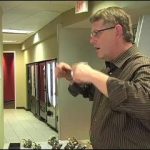We may receive a commission when you use our affiliate links. However, this does not impact our recommendations.
One of the unique things about Popular Woodworking’s Arts and Mysteries column is that it has long, sometimes year long, series. Let’s face it. Woodworking magazines have been in print for a long long time. Almost everything has been written or done before.
Well, that’s not quite true. See, the basic structural way magazine articles are written effects the final product. If you have a team of editors and cameramen traveling to an author, you can only get so much of the “in-process” detail. My “forme” took me over a week to build. And I was snapping pictures, and writing the article at each phase in the construction while all the details were fresh in my mind.
PW encourages authors to be photographers. This has got to be cheaper than sending crews to faraway lands. But I see a huge advantage to this arrangement. I think we can look at a subject in levels of detail never before possible. Digital photography has really helped make this possible. But the vision and leadership of Popular Woodworking magazine has brought it to print.
Next time you are reading your favorite ww magazine, ask yourself if the pictures you see are staged and if you are really getting a detailed accounting of construction. Had I never written for a magazine, I doubt I would ask myself this question, which is why I pose it here. How does the structure of the relationship between author and publisher effect the final product we read?
To my thinking, it’s almost like the difference between a documentary and a dramatic scripted film. I think I prefer the documentary. Especially those revolutionary war documentaries on the History channel.! It’s amazing how that film has lasted this long!
Adam
P.S. I don’t get the History channel 🙁
Here are some supplies and tools we find essential in our everyday work around the shop. We may receive a commission from sales referred by our links; however, we have carefully selected these products for their usefulness and quality.









Hi Adam,
I appreciate the photos from a number of standpoints. One of which is that a picture communicates many things all at once. It helps you imagine doing something yourself, like tackling a more difficult project or something quite new. So a natural depiction of something holds more learning value for me. I am biased though in being a graphic oriented learner.
I have a question too. In the August issue of PW you show what looks like a handmade brace. I got the picture, no pun intended, on using spoon bits in your brace through the article. Any suggestions for someone who might want to make a similar type brace? Should I find an antique one and make a copy so it is more durable. I am kinda of partial to the clothespin type, but I like the style of brace you illustrated.
I occasionally volunteer at a revolutionary war era homestead and demonstrate woodworking. I’ve made some tools myself, but I am finding that I have to be more selective on how much time I invest on it versus actually making furniture.
Regards,
Jim
I wholeheartedly agree. Staged photographs are the bane of the crafts publishing field. The reader looks at the carefully posed scenario and examines posture, hand placement, lighting, you name it and assumes that all these features are of the utmost importance. It’s all to easy to discern a photograph taken for the purpose of ‘looking good’ and one taken for the purpose of teaching.
But then, many old engraved images show the same problem. Artistically sound, but full of practical errors.
BTW… I’m sorry to have to destroy your happiness, but those revolutionary war documentaries are also staged. It was a Union thing. Basic wages and all that.